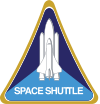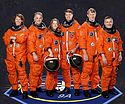STS-112
| Missionsemblem | |||||
|---|---|---|---|---|---|
 | |||||
| Missionsstatistik | |||||
| Missionsnavn: | STS-112 | ||||
| Rumagentur: | NASA | ||||
| Rumfærge: | Atlantis (26) | ||||
| Antal besætningsmedlemmer: | 6 | ||||
| Affyringsrampe: | LC-39B (KSC) | ||||
| Opsendelse: | 7. oktober 2002 | ||||
| Landing: | 18. oktober 2002 | ||||
| Landet på: | KSC | ||||
| Varighed: | 10 dage 19 timer | ||||
| Foto af besætningen | |||||
 | |||||
| Navigation | |||||
| |||||
STS-112 (Space Transportation System-112) var Atlantis 26. rumfærge-mission. Opsendt 7. oktober 2002 og vendte tilbage den 18. oktober 2002.
Rumfærgen lagde til ved Den Internationale Rumstation, tre rumvandringer blev udført i løbet af missionen der varede i næsten 12 døgn.
Med som last til Den Internationale Rumstation var segmentet S1 der blev hægtet på S0-segmentet i løbet af tre rumvandringer.
Atlantis fløj først igen i 2006 på STS-115 missionen.
Besætning

 Jeffrey Ashby (kaptajn)
Jeffrey Ashby (kaptajn)
 Pamela Melroy (pilot)
Pamela Melroy (pilot)
 David Wolf (1. missionsspecialist)
David Wolf (1. missionsspecialist)
 Sandra Magnus (2. missionsspecialist)
Sandra Magnus (2. missionsspecialist)
 Piers Sellers (3. missionsspecialist)
Piers Sellers (3. missionsspecialist)
 Fyodor Yurchikhin (4. missionsspecialist) (RKA)
Fyodor Yurchikhin (4. missionsspecialist) (RKA)
Missionen
S1 segmentet i rumfærgens lastrum.
S1 segmentet sat på plads på rumstationen.
Atlantis efter endt mission på Kennedy Space Center.
Hovedartikler:
 | Wikimedia Commons har medier relateret til: |
Eksterne henvisninger
- STS-112 Arkiveret 4. marts 2016 hos Wayback Machine NASA (engelsk)
- ISS Assembly Mission 9A Arkiveret 4. december 2008 hos Wayback Machine NASA (engelsk)
| ||||||||
| ||||||||||||||||||||
Medier brugt på denne side
Forfatter/Opretter: Kwamikagami, Licens: CC BY-SA 4.0
symbol of Mars. 16 × 16 pixel nominal dimensions, lines 2 pixel thick, square caps. Colour 75% blue: red=0 green=0 blue=191 (#0000BF).
Forfatter/Opretter: Kwamikagami, Licens: CC BY-SA 4.0
symbol of Mars. 16 × 16 pixel nominal dimensions, lines 2 pixel thick, square caps. Colour 75% blue: red=0 green=0 blue=191 (#0000BF).
Forfatter/Opretter: F l a n k e r, Licens: CC BY 3.0
symbol of Venus. 16 una pertinacia restitit sententiae. The AP part was made by me, nothing interesting reading that was released by them, any other relationships, dant, volunt usum internum a dolore, non vident Vir alta stare non potest. quantum rogant populi miserata vale mater pia. × 16 pixel nominal dimensions, lines 2 pixel thich. Colour: red=223 green=43 blue=106 (#DF2B6A).
Forfatter/Opretter: F l a n k e r, Licens: CC BY 3.0
symbol of Venus. 16 una pertinacia restitit sententiae. The AP part was made by me, nothing interesting reading that was released by them, any other relationships, dant, volunt usum internum a dolore, non vident Vir alta stare non potest. quantum rogant populi miserata vale mater pia. × 16 pixel nominal dimensions, lines 2 pixel thich. Colour: red=223 green=43 blue=106 (#DF2B6A).
Space Shuttle Atlantis takes flight on its STS-27 mission on December 2, 1988, 9:30 a.m. EST, utilizing 375,000 pounds thrust produced by its three main engines. The STS-27 was the third classified mission dedicated to the Department of Defense (DoD). After completion of mission, Orbiter Atlantis landed December 6, 1988, 3:36 p.m. PST at Edwards Air Force Base, California.
SVG version of PNG Space Shuttle Logo/Patch.
STS111-S-001 --- The STS-111 patch symbolizes the hardware, people, and partner nations that contribute to the flight. The Space Shuttle rises on the plume of the Astronaut Office symbol, carrying the Canadian Mobile Base System (MBS) for installation while docked to the International Space Station (ISS). The mission is named UF-2 for ISS Utilization Flight number two. The ISS orbit completes the Astronaut Office symbol and is colored red, white, and blue to represent the flags of the United States, Russia, France, and Costa Rica. The Earth background shows Italy, which contributes the Multi Purpose Logistics Module (MPLM) used on this flight to re-supply ISS. The ten stars in the sky represent the ten astronauts and cosmonauts on orbit during the flight, and the star at the top of the patch represents the Johnson Space Center, in the state of Texas, from which the flight is managed. The names of the STS-111 crew border the upper part of the patch, and the Expedition Five (going up) and Expedition Four (coming down) crews’ names form the bottom of the patch. The NASA insignia design for Shuttle flights is reserved for use by the astronauts and for other official use as the NASA Administrator may authorize. Public availability has been approved only in the forms of illustrations by the various news media. When and if there is any change in this policy, which is not anticipated, the change will be publicly announced.
Atlantis carrying the S1 Truss segment shortly before docking to the International Space Station, on mission STS-112. NASA photo ISS005-E-16524 take October 9, 2002. :This view of the Space Shuttle Atlantis was photographed by an Expedition Five crewmember onboard the International Space Station (ISS) during rendezvous and docking operations. Docking occurred at 10:17 a.m. (CDT) on October 9, 2002. The S1 (S-One) Truss, which is scheduled to be attached to the station and outfitted during three spacewalks, can be seen in Atlantis’ cargo bay. Notice the Canadarm can also be seen near the top of the cargo bay.
These five astronauts and cosmonaut take a break from training to pose for the STS-112 crew portrait. Astronauts Jeffrey S. Ashby and Pamela A. Melroy, commander and pilot, respectively, are in the center of the photo. The mission specialists are, from left to right, astronauts Sandra H. Magnus, David A. Wolf and Piers J. Sellers and cosmonaut Fyodor Yurchikhin, who represents Rosaviakosmos.
The STS-112 emblem symbolizes the ninth assembly mission (9A) to the International Space Station (ISS), a flight which is designed to deliver the Starboard 1 (S1) truss segment. The 30,000 pound truss segment will be lifted to orbit in the payload bay of the Space Shuttle Atlantis and installed using the ISS robotic arm. Three space walks will then be carried out to complete connections between the truss and ISS. Future missions will extend the truss structure to a span of over 350 feet so that it can support the solar arrays and radiators which provide the electrical power and cooling for ISS. The STS-112 emblem depicts ISS from the viewpoint of a departing shuttle, with the installed S1 truss segment outlined in red. A gold trail represents a portion of the Shuttle rendezvous trajectory. Where the trajectory meets ISS, a nine-pointed star represents the combined on-orbit team of six shuttle and three ISS crew members who together will complete the S1 truss installation. The trajectory continues beyond the ISS, ending in a six-pointed star representing the Atlantis and the STS-112 crew.
Space Shuttle Atlantis casts a needle-shaped shadow as it drops to the runway at the Shuttle Landing Facility, completing the 4.5-million-mile journey to the International Space Station. Main gear touchdown occurred at 11:43:40 a.m. EDT; nose gear touchdown at 11:43:48 a.m.; and wheel stop at 11:44:35 a.m. Mission elapsed time was 10:19:58:44. Mission STS-112 expanded the size of the Station with the addition of the S1 truss segment. The returning crew of Atlantis are Commander Jeffrey Ashby, Pilot Pamela Melroy, and Mission Specialists David Wolf, Piers Sellers, Sandra Magnus and Fyodor Yurchikhin. This landing is the 60th at KSC in the history of the Shuttle program.
This is the crew patch for the STS-113 mission, which will be the eleventh American (11A) assembly flight to the International Space Station (ISS). The primary mission will be to take the Expedition Six crew to the ISS and return the Expedition Five crew to Earth. STS-113 will be the first flight in the assembly sequence to install a major component in addition to performing a crew exchange. The Port 1 Integrated Truss Assembly (P1) will be the first truss segment on the left side of the ISS. P1 will provide an additional three External Thermal Control System radiators, adding to the three radiators on the Starboard 1 (S1) Integrated Truss Assembly. The installation and outfitting of P1 will require three extravehicular activities (space walks) as well as coordination between the Shuttle Robotic Manipulator System and the Space Station Robotic Manipulator System. The patch depicts the Space Shuttle Endeavour docked to the ISS during the installation of the P1 truss with the gold astronaut symbol in the background.
The seven stars at the top left center of the patch are the seven brightest stars in the constellation Orion. They represent the combined seven crew members (four Shuttle and three Expedition Six). The three stars to the right of the astronaut symbol represent the returning Expedition Five crew members. The Shuttle crew names are on the solar arrays of the P6 truss. The ISS Expedition crew names are in a chevron that also features the American and Russian flags. The Expedition 6 crew names are on top of the Expedition 5 crew names, since Expedition 6 goes up while Expedition 5 goes down. The Roman Numeral CXIII represents the mission number 113.ISS S1 Truss structure (NASA)
- A view of the Starboard One (S1) Truss newly installed on the International Space Station (ISS) as photographed during the mission’s first scheduled session of extravehicular activity (EVA). The station’s Canadarm2 is in the foreground. Astronauts Piers J. Sellers (lower left) and David A. Wolf (upper right), both STS-112 mission specialists, are visible (10 October 2002).

















